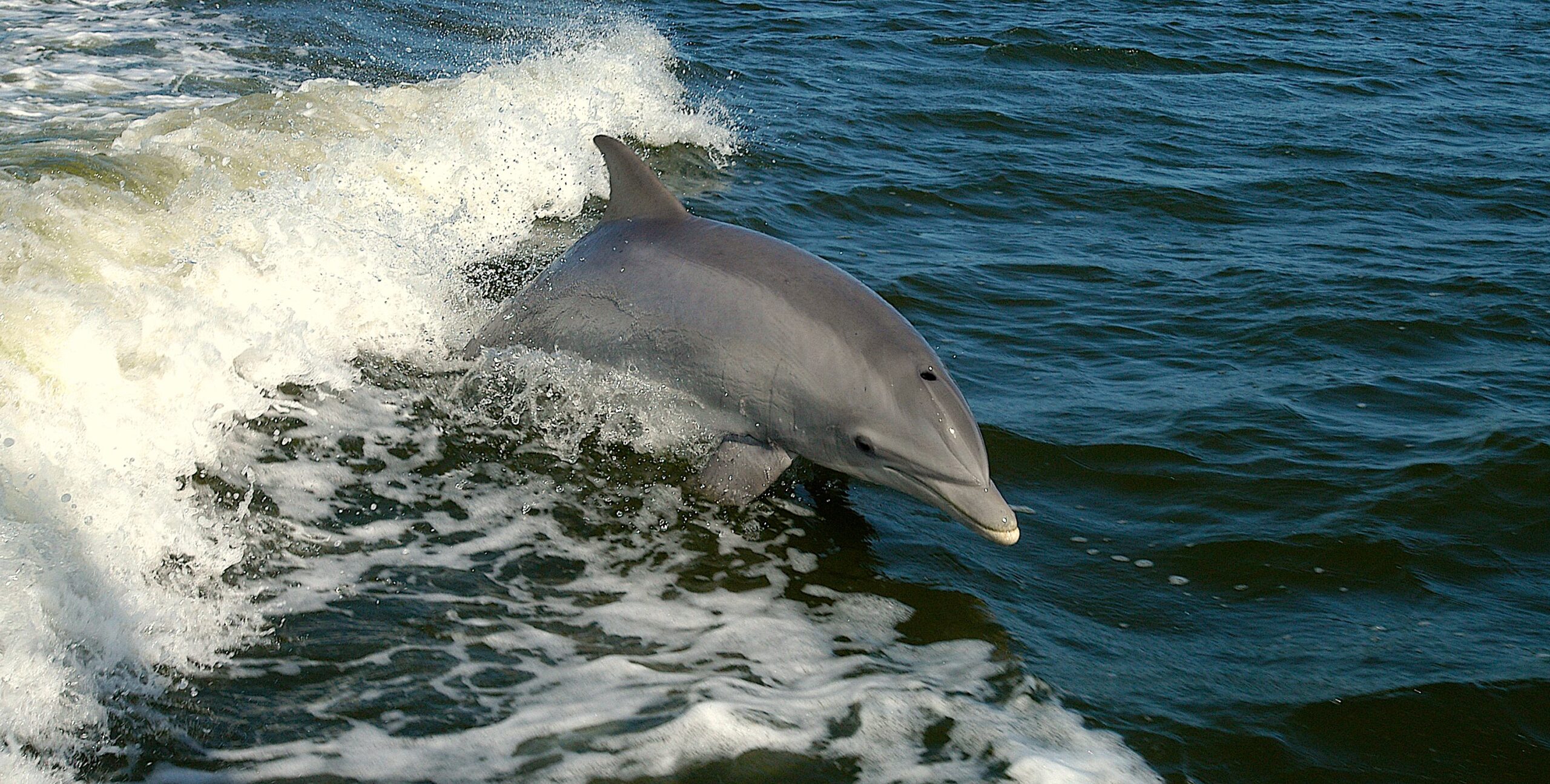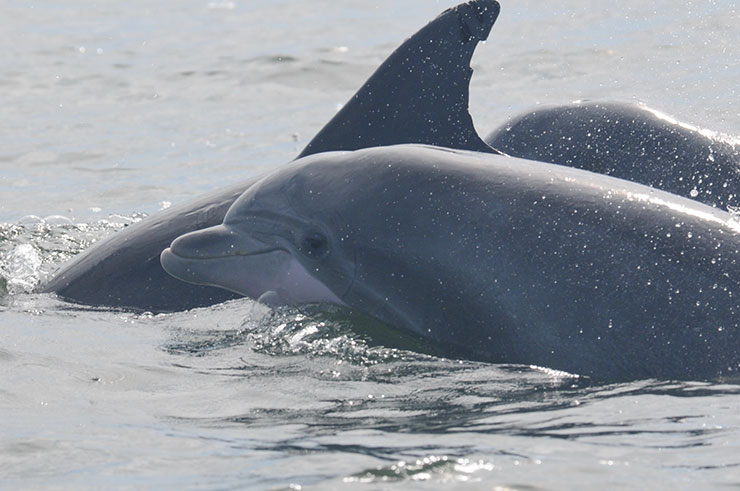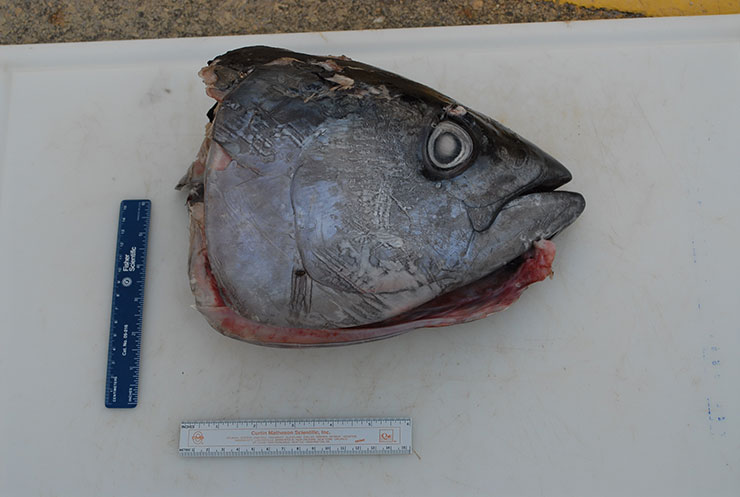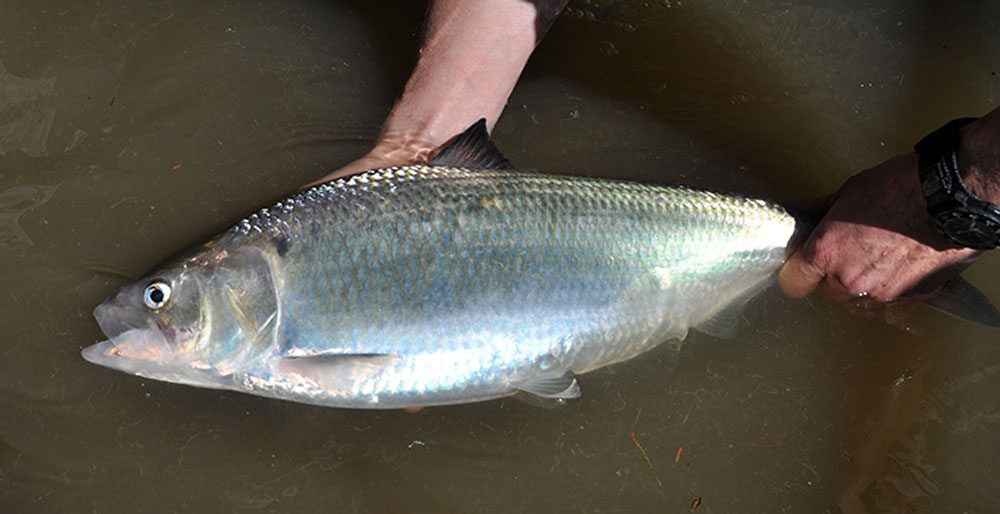SEA SCIENCE: Riding the Waves: Identifying and Protecting Marine Mammals

Marine mammals, such as dolphins and whales, are interactive creatures. Coastal visitors are entranced by their antics and researchers are intrigued by their behavior.
In this part of the world, bottlenose dolphins are the marine mammal species we see most often, yet we are still learning about them, their movement patterns, and the diseases that affect them,” says Vicky Thayer, marine mammal stranding coordinator for central North Carolina. “I think we are intrigued by them because they are large and long-lived and the mystery of what we still do not know is attractive to people.”
These top-level predators “can serve as sentinels of the health of coastal marine ecosystems,” she adds.
Between July and October 2013, about 700 dolphins stranded along the U.S. East Coast, drawing the attention of scientists and coastal residents.
The highest numbers were just to our north. “Virginia has seen mortalities of roughly 500 bottlenose dolphins and they are making an extraordinary effort to respond to every animal, even the highly decomposed ones,” says Craig Harms of North Carolina State University’s College of Veterinary Medicine, who is part of the network responding to strandings. However, the longer animals are stranded or are left out in the elements, the more their tissues decompose, making it harder to determine the cause of death.
North Carolina stranding networks normally respond to between 125 and 175 marine mammals, including bottlenose dolphins, over an entire year, according to Ann Pabst, who teaches biology and marine biology and is co-director of the Marine Mammal Stranding Program at the University of North Carolina Wilmington. “This year we are already at 201, 165 of which have been bottlenose dolphins,” she says, referring to overall marine mammal strandings that occurred through the beginning of November.

As the strandings mounted, the National Oceanic and Atmospheric Administration’s National Marine Fisheries Service declared the bottlenose dolphin strandings on the East Coast an Unusual Mortality Event (UME). The Marine Mammal Protection Act defines a UME as “a stranding event that is unexpected, involves a significant die-off of any marine mammal population and demands immediate response.”
A majority of the bottlenose dolphin deaths in the 2013 Bottlenose Dolphin UME in the Mid-Atlantic has been linked to the cetacean morbillivirus. The virus spreads through the exhaled spray from contaminated dolphins. “Because of their coordinated breathing patterns as they swim along, they are roughly surfacing one after the other around the same time,” Harms explains. Those habits enable the virus to spread easily.
Morbillivirus is similar to canine distemper in dogs and measles in humans but the virus is not considered transmissible to humans. However, NOAA is advising people — and their pets — to stay away from stranded dolphins because they could carry secondary bacterial infections.
The morbillivirus was seen in 1987 and 1988 within the Northern Migratory stock of bottlenose dolphins. But the virus is not limited to this specific population. “It seems like this time, as well as in ’87 and ’88, that it was initially identified in the Northern Migratory stock. And then as they move south, it moves south,” Harms explains. “If it spills over to a susceptible species or population, then it can start spreading and showing the clinical signs and mortalities.”
DOLPHIN PHOTO IDENTIFICATION
As of early November 2013, there were 17 confirmed cases of cetacean morbillivirus in North Carolina. One way to monitor the extent of the disease and other population-wide problems that affect dolphins is to use dorsal fin identification to map sightings. Throughout their lives, dolphins acquire nicks, notches and scarring on thin tissue on the trailing edge of their dorsal fins. These markings help researchers distinguish an individual dolphin within a group of dolphins.
The success of this work is dependent on a large collaborative effort of researchers, students, and volunteers along the east coast,” explains Keith Rittmaster of the North Carolina Maritime Museum who has been involved in dorsal fin photo-identification and stranding response since 1985.
In 1997, the Mid-Atlantic Bottlenose Dolphin Catalog, or MABDC, was developed to coordinate and archive dorsal fin images taken by different researchers along the East Coast. The catalog is used to compare images among sites to create a sighting map and potentially identify to which population an individual dolphin belongs. When a sick or dead dolphin is found, the catalog helps scientists determine the dolphin’s stock of origin.
“It is important for conservation to be able to identify which population these dolphins come from because we want to be able to manage those populations effectively in case one population is hit harder than another,” says Kim Urian, MABDC curator, who is based in Beaufort, N.C.
There are about 7,000 individual bottlenose dolphins in the catalog. Researchers compare dorsal fin pictures taken in the field to images within the MABDC. In order to locate a dorsal fin match, some researchers use software that traces a fin and then compares it to other dorsal fins within the catalog. If a fin matches an existing image, a sighting history of the specific animal can be created, with repeat encounters for that individual recorded over time. If a match is not available, that dorsal fin is added as a new entry, along with information on where the dolphin was sighted. Researchers also use the catalog to determine what populations experience interactions with fisheries.
Urian works with networks from New Jersey, Virginia, North Carolina and South Carolina to identify dolphin strandings that involve fisheries interactions. This effort is supported by NOAA’s Bycatch Reduction of Marine Mammals in Mid-Atlantic Fisheries program, which is administered by North Carolina Sea Grant. Previously, this work also was funded by the N.C. Fishery Resource Grant Program, or FRG, also administered by Sea Grant.

Stranding networks follow a set protocol for identifying net marks or other indications of a fisheries interaction. If a bottlenose dolphin shows signs of fishery interactions, Urian will attempt to determine a specific animal’s stock with a sighting map. Fishery interactions are documented within the catalog, along with sighting locations. Researchers try to identify the stock for a bottlenose dolphin, “in order to assign mortality to a particular stock or unit,” she explains.
Urian’s work depends on the National Marine Mammal Stranding Network that responds to stranded marine mammals for data collection. The network also conducts possible treatment and rehabilitation. The John H. Prescott Marine Mammal Rescue Assistance Grant Program, distributed by NOAA Fisheries, supports the national network. Since it was established in 2000, the program has funded more than $41.8 million for stranding teams, including more than $2 million for North Carolina. However, funding was drastically reduced for the program’s new fiscal year, which begins this December.
North Carolina, South Carolina and Virginia did not receive new Prescott Grants. Harms predicts that these three states will continue to see the UME as the virus moves south along the East Coast from fall to winter and then back north in the spring.
“The funding cut happened right as we have the Unusual Mortality Event that has really slammed Virginia,” Harms explains. “It takes continued support to have people like Vicky who are highly trained, have the expertise and can respond to the stranding events.” Skilled personnel, such as Thayer, are trained to reduce stress for the animal when it is moved, euthanize it humanely and take accurate diagnostic samples.
Thayer is able to stretch out her current funding for the central part of the state until March 2014, when marine mammal strandings normally peak. But after that, “if an animal strands on the beach, it will remain there unless someone volunteers to do something,” she says.
“It will definitely impact how the data is collected, or even if we will continue to get dorsal fin images because if people aren’t funded to go and respond to these stranding events, then we are going to miss out on a lot of information on those animals,” Urian adds.
DIVERTING PILOT WHALES
Dolphins are just one species of marine mammals that are being studied through the NOAA Fisheries program administered by Sea Grant.
The program also supports experiments with acoustic dissuasive devices to keep pilot whales away from pelagic longlines. This study is headed by Andrew Read of Duke University Marine Lab and Outer Banks fisherman Dewey Hemilright, along with fisherman Matt Huth and researcher Danielle Waples of Duke.
Their current work builds on Read’s previous acoustic deterrent research, part of which had been funded through the NOAA Fisheries and FRG programs.
Ranging from Greenland to Florida, long- and short-finned pilot whale species potentially overlap in the Mid-Atlantic near Cape Hatteras. Pilot whales, protected under the Marine Mammal Protection Act, are drawn to the bait or fish on the line as an easy, pursuit-free meal.
The interactive acoustic devices are put on the main line to keep pilot whales away from the bait or catch. They produce a sound that the manufacturers suggest will repel the whales as the animals approach the gear, Read explains. “The devices work by detecting the calls of pilot whales in theory — and projecting that aversive stimulus when the animals are around the gear,” he adds.
“A sound emitter just continually producing a stimulus will just alert pilot whales to where the longline is for them to go eat,” Read says. “It’s a hard behavior to overcome, but we think there is some potential for these interactive devices to be more promising.”
According to Hemilright, pilot whale interactions are few and far between, making research with acoustic devices challenging, “You do not see pilot whales every day,” he says. “It’s such a rare occurrence.” An acoustic recorder placed on longline gear provides additional confirmation that the aversive sound is going off when pilot whales are nearby. Recorders also determine characteristics of the sound.
However, when pilot whales find an enticing bait line, they can wipe out an entire catch. Hemilright tells of an occasion when he was setting out baited longline hooks with two other fishing boats when pilot whales approached. “We turned around and hauled up 150 hooks and all the bait we had just set was gone,” he recalls.
Depredation also occurs when pilot whales take fish from fishing gear. “Interactions can also involve animals becoming entangled, which has a cost for the animals and essentially a conservation cost that the fishermen are going to have to deal with,” Read says.
“We’re looking at ways to fix the problem because the other option — if we don’t reduce the potential interactions — is there could be closures,” Hemilright says.
“We have a long history of working with North Carolina fishermen to try and solve some of these problems with the protected species,” Read continues. “One of the reasons we like to work with fishermen is because they know how their gear is used better than anybody else and they often have very good ideas that need to be tested.”
The partnership is beneficial on many counts.
“They don’t necessarily have the time or resources to conduct scientific experiments so that’s where we come in to partner with fishermen and help them conduct scientific experiments in the field with their gear with the way it’s actually fished,” Read says. “I think those types of field experiments are very powerful because they tell us whether or not a particular measure will work in the real world.”
Meetings of the Pelagic Longline Take Reduction Team, of which Read and Hemilright are members, provide a venue for fishermen, resource managers, researchers and government agencies to discuss or evaluate ideas to reduce fisheries interactions with marine mammals.
It’s a continual thought process to try and find a mitigation strategy,” Read says. “It’s not just pelagic longlines off Cape Hatteras where this issue of fisheries interactions is. It occurs all over the world. It’s a global issue and we’re trying to be at the forefront for finding a solution for it.”
BOTTLENOSE DOLPHIN POPULATIONS IN NORTH CAROLINA
The NOAA Fisheries Bottlenose Dolphin Stock Assessment Report lists four populations of dolphins that overlap in North Carolina waters.
• The Northern Migratory Stock ranges from Long Island, N.Y., to the Chesapeake Bay in Maryland in the summer months. However, in the winter, these dolphins migrate as far south as the North Carolina and Virginia border to Cape Lookout.
• The Southern Migratory Stock is presumed to occupy waters from the Chesapeake Bay south to northern Florida. This stock overlaps with the Northern N.C. Estuarine System and the Southern N.C. Estuarine System populations.
• The Northern N.C. Estuarine System Stock is found in the estuarine waters of Pamlico Sound during July and August. These dolphins also are known to overlap with the Northern Migratory Stock between Cape Lookout and Cape Hatteras.
• The Southern N.C. Estuarine System Stock ranges from Core Sound to the North Carolina and South Carolina border. In the winter months, this stock moves to waters near the Cape Fear River and mixes with the Southern Migratory Stock.
This article was published in the Holiday 2013 issue of Coastwatch.
For contact information and reprint requests, visit ncseagrant.ncsu.edu/coastwatch/contact/.
- Categories:

